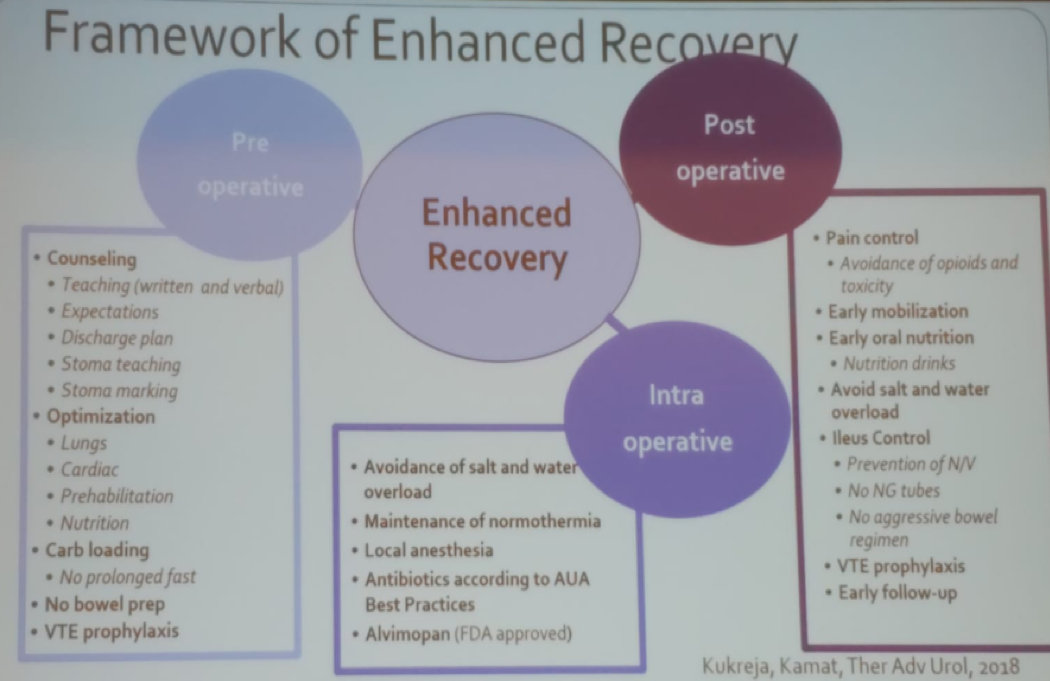Athens, Greece (Urotoday.com) Dr. Ashish Kamat gave a brief overview of enhanced recovery after surgery (ERAS) in patients undergoing radical cystectomy and provided some data on the comparison of robotic and open radical cystectomy.
In the past, before the implementation of the ERAS pathway, surgery was planned “as soon as possible,” with no training or conditioning of the patient. All patients underwent bowel preparation (both mechanical and antibiotic). Additionally, all patients were instructed not to eat anything before the night of surgery, and patients were put on a clear fluid diet 1-2 days before surgery. At the beginning of surgery all patients received compensatory overhydration, with aggressive hydration during the case. Following the surgery, a nasogastric tube was placed, and the patient was not allowed to eat anything until flatus. Lastly, opioid analgesia was given on a standard basis, limiting mental acuity and mobility. In this type of traditional care, the average stay in the US after radical cystectomy was 10 days, and even more than that in Europe and Asia. Importantly, the complication rate was approximately 60% with a hospital readmission rate of 30%.
The framework of the ERAS pathway designed to improve all aspects of the procedure and improve patient recovery and outcomes is outlined in a summarized manner in Figure 1. This framework entails actions that should be implemented in the preoperative, operative, and postoperative settings. The ERAS pathway originally came from colorectal surgeries showing significant improvement in patient recovery and outcomes.1 This enhanced recovery pathway has been implemented successfully in patients undergoing radical cystectomy and has been steadily gaining popularity around the world.
In the last part of this talk, Dr. Kamat moved on to discuss the trials comparing robotic and open standard radical cystectomy. The landmark trial published by Bochner et al. in the New England Journal of Medicine2 demonstrated that with robotic cystectomy there is 181 cc less amount of blood loss (500 cc vs. 681 cc, p=0.027). In another landmark trial, published in the Lancet, the RAZOR trial,3 robotic cystectomy was compared to open cystectomy as well. In this trial the estimated blood loss difference was more significant, 300 cc vs. 700 cc, p<0.001 (robotic vs. open). The length of hospital stay was lower in the robotic cases by one day (6 vs. 7 days, p=0.02), and the operation time was longer (428 vs. 361 minutes, p=0.005).
A major limitation precluding the adoption of robotic cystectomy in more centers is its high cost. A cost-effectiveness modeling study of robotic vs open radical cystectomy for bladder cancer showed that in the 90-day model, the cost of robotic cystectomy was 3,761 Euro higher than an open radical cystectomy.4 It was found that for robotic cystectomy to save costs it would need to meet the following conditions:
- The length of hospital stay should be 4 days or less
- The operating time should be limited to 175 minutes or less,
- The robotic equipment costs cannot go over 281 Euro.4
Figure 1 – Framework of enhanced recovery after surgery:

Presented by: Ashish Kamat, MD, MBBS, Professor of Urology and Wayne B. Duddleston Professor of Cancer Research at MD Anderson Cancer Center in Houston, Texas. Dr. Kamat serves as; President of International Bladder Cancer Group, Co-President of International Bladder Cancer Network, and Associate Cancer Center Director. Dr. Kamat served as the Program Director, of the MD Anderson Urologic Oncology Fellowship from 2005-2016.
Written By: Hanan Goldberg, MD, Urology Department, SUNY Upstate Medical University, Syracuse, New-York, USA @GoldbergHanan at the 39th Congress of the Société Internationale d’Urologie, SIU 2019, #SIUWorld #SIU2019, October 17-20, 2019, Athens, Greece
References:
- Gustafsson UO, Scott MJ, Hubner M, et al. Guidelines for Perioperative Care in Elective Colorectal Surgery: Enhanced Recovery After Surgery (ERAS((R))) Society Recommendations: 2018. World journal of surgery 2019; 43(3): 659-95.
- Bochner BH, Sjoberg DD, Laudone VP. A randomized trial of robot-assisted laparoscopic radical cystectomy. The New England journal of medicine 2014; 371(4): 389-90.
- Parekh DJ, Reis IM, Castle EP, et al. Robot-assisted radical cystectomy versus open radical cystectomy in patients with bladder cancer (RAZOR): an open-label, randomised, phase 3, non-inferiority trial. Lancet (London, England) 2018; 391(10139): 2525-36.
- Michels CTJ, Wijburg CJ, Leijte E, Witjes JA, Rovers MM, Grutters JPC. A cost-effectiveness modeling study of robot-assisted (RARC) versus open radical cystectomy (ORC) for bladder cancer to inform future research. Eur Urol Focus 2018.
